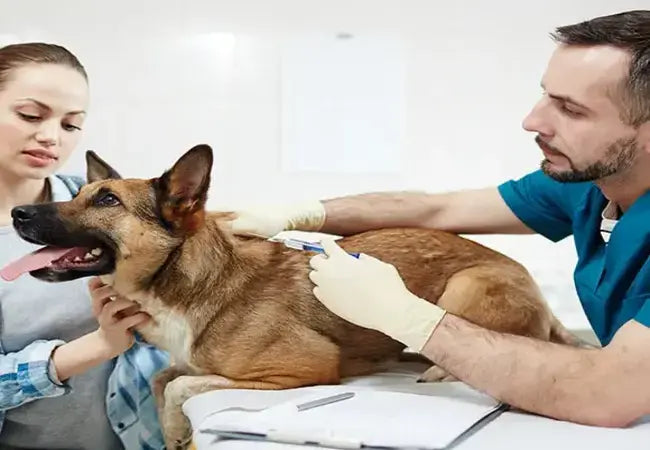Vet’s 2025 Guide to Canine Pyothorax 🩺 Diagnosis, Aggressive Treatment & Recovery

In this article
Vet’s 2025 Guide to Canine Pyothorax 🩺 Diagnosis, Aggressive Treatment & Recovery
By Dr. Duncan Houston BVSc
💡 What Is Pyothorax?
Pneumothorax is the accumulation of pus in the pleural space—the chest cavity surrounding the lungs—commonly due to penetrating injuries (bites, grass awns), lung abscess rupture, or severe pneumonia. It leads to major respiratory distress that can rapidly worsen over 24–48 hours.
🫁 Who’s at Risk & How Common Is It?
- Often seen in active, outdoor dogs—like sporting or hunting breeds—that suffer chest trauma.
- Anywhere foreign bodies like foxtails or sharp plant awns can penetrate lung tissue.
- Also secondary to migrating grass awns, bacterial pneumonia, or chest surgery complications.
⚠️ Signs & Symptoms
- Respiratory distress: rapid shallow breathing, open-mouthed breathing, cough, reluctance to lie down.
- Fever, lethargy, loss of appetite, and weight loss.
- Painful chest, muffled lung sounds, possible shock signs—pale gums, weakness.
🧪 Diagnostic Work-Up
- Thoracic imaging: X-rays or ultrasound reveal pleural fluid, lung consolidation, collapsed areas, or masses.
- Pleural fluid analysis: Cytology (microscopy + Gram stain), aerobic/anaerobic cultures required.
- Lab tests: CBC, biochemistry to assess infection, organ function; blood gas for severe cases.
- CT or ultrasound guidance: to identify foreign bodies like grass awns when suspected.
❤️ Treatment Protocols in 2025
1. Hospitalization & Critical Support
- ICU-level care with IV fluids to maintain blood pressure and electrolytes.
- Thoracocentesis (chest taps) to relieve respiratory distress in an emergency.
- Chest tube (thoracostomy) placement under anesthesia or sedation allows continuous drainage and lavage.
2. Chest Lavage
Warm sterile saline is used to lavage the pleural space through chest tubes every 4–12 hours during the first 24–48 hours—helps clear debris and infection.
3. Antibiotic Therapy
- Start broad-spectrum IV antibiotics targeting aerobes & anaerobes: ampicillin-sulbactam + enrofloxacin + clindamycin preferred.
- Adjust based on culture/sensitivity—clindamycin monotherapy is usually insufficient.
- Continue antibiotics for 2 weeks beyond resolution of clinical and radiographic signs (total 1–3 months).
4. Surgery When Needed
- Indicated if foreign bodies are present, loculated fluid pockets, lung lobe abscess, or mediastinal involvement.
- Thoracotomy allows the removal of debris, tissue debridement, chest tube placement post-operation.
5. Adjunctive Supportive Care
- Pain management with opioids and NSAIDs.
- Encouraged light activity (5–10 minutes) every 6–8 hours to support lung function.
- Supplemental oxygen therapy is needed.
📅 Recovery & Prognosis
- Hospitalization typically lasts 7–14 days; chest tubes are removed when fluids are clear and infection under control.
- Follow-up includes monthly rechecks with CBC, bloodwork, and chest X-rays until full resolution.
- Long-term prognosis is good—survival reported between 63–95% depending on the study and care approach.
- Without treatment, pyothorax is fatal.
🏡 Ask A Vet At‑Home Support
- Log respiratory rate, cough, activity, appetite and demeanour daily.
- Receive reminders for medications and follow-up X‑rays.
- Flag signs of relapse—fever, lethargy, breathing difficulty.
- Upload photos/radiograph summaries and stay connected with your vet remotely.
- Guidance for gradually increasing exercise as recovery progresses.
🔍 Key Takeaways
- Pneumonitis is an emergency—prompt, aggressive care saves lives.
- Chest drainage + lavage + broad-spectrum antibiotics are core treatment.
- Surgery may be necessary if foreign material or abscesses are present.
- Aftercare and monitoring are essential to prevent relapse.
- With 2025 protocols and home support like Ask A Vet, recovery rates are high.
🩺 Conclusion ❤️
Pyothorax is serious, but today’s ICU-level care, including thoracostomy, lavage, culture-driven antibiotics, and surgical options, offers great chances of recovery. For owners, Ask A Vet provides continuous support post-discharge—tracking symptoms, managing meds, and ensuring timely follow-ups. Your dog's road to recovery is guided every step of the way. 🐕✨
Dr Duncan Houston BVSc – integrating emergency veterinary expertise with at-home owner support.
Visit AskAVet.com and download the Ask A Vet app to monitor breathing, track meds, schedule rechecks, and stay connected with your vet from home. ❤️






